
The Paluxy River, also known as Paluxy Creek, is a river in the U.S. state of Texas. It is a tributary of the Brazos River. It is formed by the convergence of the North Paluxy River and the South Paluxy River near Bluff Dale, Texas in Erath County and flows a distance of 29 miles (47 km) before joining the Brazos just to the east of Glen Rose, Texas in south central Somervell County.

Therizinosauridae is an extinct family of derived (advanced) therizinosauroid dinosaurs whose fossil remains have been found in mostly Late Cretaceous boundary. Even though representative fossils have only been found throughout Asia and North America, the range of Therizinosauridae is believed to have spanned much of the supercontinent of Laurasia based on several footprints and isolated remains in Europe and Africa. Currently, Therizinosauridae comprises eight described and named taxa.
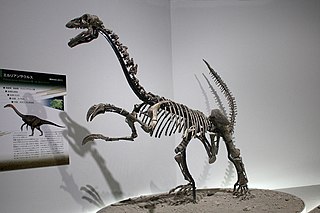
Erliansaurus is a genus of therizinosaur theropod dinosaur that lived in Asia during the Cenomanian stage of the Late Cretaceous period in what is now Nei Mongol, Iren Dabasu Formation.
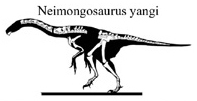
Neimongosaurus is a genus of herbivorous therizinosaur theropod dinosaur that lived in Asia during the Cenomanian stage of the Late Cretaceous period in what is now the Iren Dabasu Formation.

Dinosaur Stampede National Monument at Lark Quarry Conservation Park in Queensland, Australia is considered to be the site of the world's only known record of a dinosaur stampede, with fossilised footprints are interpreted as a predator stalking and causing a stampede of around 150 two-legged dinosaurs. This interpretation has been challenged in recent years, with evidence suggesting it may have been a natural river crossing.

Eubrontes is the name of fossilised dinosaur footprints dating from the Late Triassic and Early Jurassic. They have been identified from France, Poland, Slovakia, Czech Republic, Italy, Spain, Sweden, Australia (Queensland), US, India, China and Brazil (South).

Palmichnium is an ichnofossil genus, interpreted as a eurypterid trackway. It has been found by many places around the world, such as Australia, Canada, United States and Wales.
Megalosauripus is an ichnogenus that has been attributed to dinosaurs. The first ever appearance of this ichnospecies is 201 - 197 million years ago during the Early Jurassic period. The last recorded appearance was 156 - 151 million years ago during the Jurassic period.
Prorotodactylus is a dinosauromorph or pterosauromorph ichnogenus known from fossilized footprints found in Poland and France. The prints may have been made by a dinosauromorph that was a precursor to the dinosaurs, possibly closely related to Lagerpeton. Fossils of Prorotodactylus date back to the early Olenekian stage of the Early Triassic, making it the oldest known dinosauromorph. Its presence during this time extends the range of the dinosaur stem lineage to the start of the Early Triassic, soon after the Permian-Triassic extinction event. Prorotodactylus is the only ichnogenus within the ichnofamily Prorotodactylidae. Two ichnospecies are known, the type P. mirus and P. lutevensis.

Jialingpus is an ichnogenus of dinosaur, likely a theropod. Its footprints have been found in the Feitianshan Formation, a low-energy lake formation. Holotype is SCFP-24, which was found in Late Jurassic (Oxfordian)-aged Yuechi tracksite at Huanglong, China. These footprints were found within the vicinity of those of the smaller theropod Minisauripus, meaning that Jialingpus likely hunted Minisauripus.

Caririchnium is an ichnogenus of ornithopod dinosaur footprint, belonging to either derived iguanodonts or basal hadrosauroids. It includes the species Caririchnium lotus from Lower Cretaceous Jiaguan Formation and C. protohadrosaurichnos from Upper Cretaceous Woodbine Formation. Specimens are also known from the Lower Cretaceous El Castellar Formation and Camarillas Formations.
Rotundichnus is an ichnogenus of dinosaur footprint. The ichnospecies Rotundichnus muchehagensis dates to the early lower Cretaceous in central Laurasia and the largest footprint, that was 87 cm (2.85 ft) long, belongs to an individual that measured 21.5 meters (70.5 ft) and weighed 36.5 tonnes.
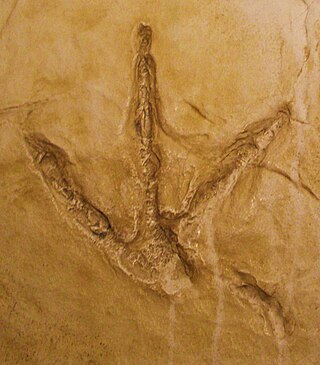
Saurexallopus is an ichnogenus of four-toed theropod footprints from the Late Cretaceous period. The type ichnospecies is S. lovei, named and described in 1996 from the Harebell Formation. The taxon was originally named Exallopus, but later renamed as Saurexallopus as the former was preoccupied by a polychaete. A second species, S.zerbsti, was named and described in 2004 from the Lance Formation. In 2012 a four-toed track from the Cantwell Formation was referred to Saurexallopus indet. It was also suggested that Saurexallopus was produced by a therizinosaur taxon. In 2013 based on skeletal proportions it was suggested that the ichnotaxon was instead produced by an oviraptorosaur taxon. In 2014 a third species was named, S.cordata, from the Wapiti Formation. In 2018 several tracks from the Blackhawk Formation were referred to Saurexallopus indet.

Tyrannosauripus is an ichnogenus of dinosaur footprint. It was discovered by geologist Charles "Chuck" Pillmore in 1983 and formally described by Martin Lockley and Adrian Hunt in 1994. This fossil footprint from northern New Mexico is 96 cm long and given its Late Cretaceous age, it very likely belonged to the giant theropod dinosaur Tyrannosaurus rex. In 2016 the size of this individual was estimated at 11.4 meters and 5.8-6.9 tonnes. Similar tridactyl dinosaur tracks in North America were discovered earlier and named Tyrannosauropus in 1971, but they were later recognized as hadrosaurid tracks and their description deemed inadequate, with Tyrannosauropus regarded as a nomen dubium. True footprints likely from Tyrannosaurus would not be found until the discovery of Tyrannosauripus. In 2007, a large tyrannosaurid track was found also in eastern Montana. In 2016, a probable fossil trackway of Tyrannosaurus was discovered in Wyoming.
Abelichnus is an extinct ichnogenus of dinosaur footprint from the Candeleros Formation and the Rio Limay Formation. The type ichnospecies, Abelichnus astigerrae, was first discovered in Argentina in 1987 and was recorded as the biggest known dinosaur footprint ever discovered. Abelichnus probably grew to a size of 12.5-13 meters long.
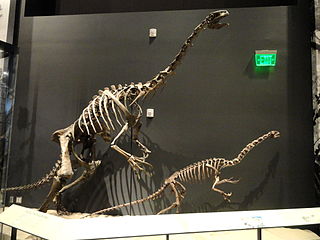
The timeline of therizinosaur research is a chronological listing of events in the history of paleontology focused on therizinosaurs. They were unusually long-necked, pot-bellied, and large-clawed herbivorous theropods most closely related to birds. The early history of therizinosaur research occurred in three phases. The first phase was the discovery of scanty and puzzling fossils in Asia by the Central Asiatic Expeditions of the 1920s and Soviet-backed research in the 1950s. This phase resulted in the discovery of the Therizinosaurus cheloniformis type specimen. Soviet paleontologist Evgeny Maleev interpreted these unusual remains as belonging to some kind of gigantic turtle.
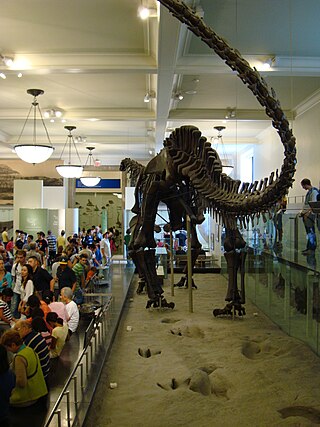
The 20th century in ichnology refers to advances made between the years 1900 and 1999 in the scientific study of trace fossils, the preserved record of the behavior and physiological processes of ancient life forms, especially fossil footprints. Significant fossil trackway discoveries began almost immediately after the start of the 20th century with the 1900 discovery at Ipolytarnoc, Hungary of a wide variety of bird and mammal footprints left behind during the early Miocene. Not long after, fossil Iguanodon footprints were discovered in Sussex, England, a discovery that probably served as the inspiration for Sir Arthur Conan Doyle's The Lost World.
This article records new taxa of trace fossils of every kind that are scheduled to be described during the year 2019, as well as other significant discoveries and events related to trace fossil paleontology that are scheduled to occur in the year 2019.

Bellatoripes is an ichnogenus of footprint produced by a large theropod dinosaur so far known only from the Late Cretaceous of Alberta and British Columbia in Canada. The tracks are large and three-toed, and based on their size are believed to have been made by tyrannosaurids, such as Albertosaurus and Daspletosaurus. Fossils of Bellatoripes are notable for preserving trackways of multiple individual tyrannosaurids all travelling in the same direction at similar speeds, suggesting the prints may have been made by a group, or pack, of tyrannosaurids moving together. Such inferences of behaviour cannot be made with fossil bones alone, so the record of Bellatoripes tracks together is important for understanding how large predatory theropods such as tyrannosaurids may have lived.
Wakinyantanka is an ichnogenus of footprint produced by a large theropod dinosaur from the Late Cretaceous Hell Creek Formation of South Dakota. Wakinyantanka tracks are large with three long, slender toes with occasional impressions of a short hallux and narrow metatarsals. Wakinyantanka was the first dinosaur track to be discovered in the Hell Creek Formation, which remain rare in the preservational conditions of the rocks. The potential trackmakers may be a large oviraptorosaur or a small tyrannosaurid.
















